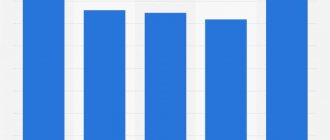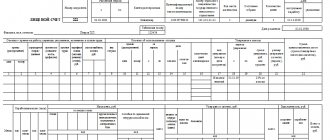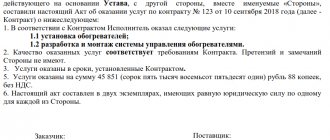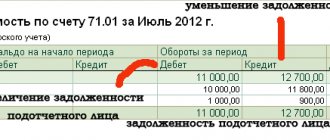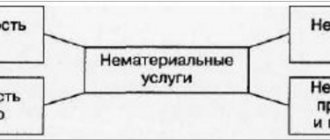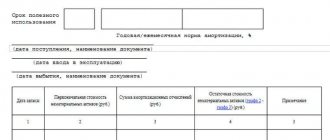Classification of production costs
All costs that arise in a manufacturing company can be divided into two groups: direct and indirect (overhead).
A specific list of types of expenses that belong to a particular group is determined by the organization itself and enshrined in its accounting policies. But, as a rule, direct costs include:
- Raw materials and materials.
- Equipment depreciation.
- Workers' wages and insurance premiums accrued on them.
Overhead costs can also be divided into two groups:
- General production.
- General economic (managerial).
The first group relates to the costs of managing the production process, and the second - to the management of the enterprise as a whole.
For example, the salary of a shop manager or foreman is general production costs, and the remuneration of a director or chief accountant is general economic costs.
How to Determine Cost-Benefit Accounting Requirements
Bibliographic description:
Vekesser, S. R. How to determine the requirements for accounting of costs and results / S. R. Wekesser. — Text: immediate // Problems of modern economics: materials of the VII International. scientific conf. (Kazan, March 2021). — Kazan: Young scientist, 2021. — pp. 25-30. — URL: https://moluch.ru/conf/econ/archive/294/13895/ (access date: 02/05/2021).
The current state of affairs requires companies to instantly respond to emerging modern trends and problems. To do this, the financial service needs to provide the company's top management with information important for making management decisions.
The cost-benefit accounting subsystem can provide sufficiently complete information necessary for operational planning (budgeting), as well as for making effective management decisions. Determining cost-benefit accounting requirements is a precursor to evaluating the process.
Cost-benefit accounting tasks typically include:
‒ provision of information for the formation of external regulated reporting, management decision-making, operational planning (budgeting) subsystems and cost calculation;
‒ ensuring the possibility of monitoring the activities of the company as a whole and assessing the results of the work of individual responsible persons in particular;
‒ identifying existing losses in business and searching for reserves for increasing the efficiency of management decisions [1].
In order to perform the listed tasks, the cost-benefit accounting subsystem must meet the requirement of completeness of the generated information. It should contain all the information necessary and sufficient for the preparation of external reporting, the full operation of other management accounting subsystems and the implementation of basic management functions (primarily decision-making and control). At the same time, it is extremely important that it is presented in the necessary analytical sections and with a sufficient degree of detail.
The list of data sufficient for the preparation of external regulated reporting is formed by its recipients (users) - government agencies (Ministry of Finance of Russia, Federal Tax Service of Russia, etc.) or auditors. It is their instructions and recommendations that serve as the basis for the requirements for this information.
The data necessary and sufficient for the operational planning (budgeting) system is determined based on its information needs. In particular, operational planning requires information about the actual implementation of plans and budgets. This means that it will be necessary to sequentially consider each of the planning forms and formulate requirements for the presentation of its indicators - in relation to analytical sections, units of measurement or regularity of formation.
Table 1 shows an example of the requirements for information support of the operational planning (budgeting) subsystem in terms of the overhead budget and the procurement plan for raw materials and basic materials. The contents of the second and third columns of this table are the requirements for the cost-benefit accounting subsystem. But that's not all. In order for the planned and actual values of indicators to be comparable, it is extremely important that the analytical reference books used in operational planning are fully consistent with the reference books of the cost-benefit accounting subsystem. Judging by Table 1, the company should have a single reference book “Nomenclature of cost items (expenses)”, which will be used both in preparing the budget for overhead costs and in the subsequent accounting of these costs. Otherwise, the budget will be formed, but a report on its execution will not be obtained. Similarly, for the procurement plan for raw materials and basic materials and for the purpose of accounting for the actual movement of these current assets, a general reference book “Raw Materials and Basic Materials” will be required.
Table 1
Requirements for information support for operational planning
| Plan (budget) form | Index | Requirements for presenting indicator values |
| Overhead budget | Overhead costs | Data must be presented based on the results of the reporting period in monetary terms: — in terms of cost items; — in terms of cost locations |
| Procurement plan for raw materials and basic materials | Material resources purchased (resources for which counterparties have obligations to supply) | 1. For all indicated indicators, both natural and cost units of measurement are used; 2. The regularity of formation of the values of all indicators (except for the indicator “Remaining material resources”) is daily; 3. For all of the listed indicators, the values are presented in the context of individual nomenclature units of raw materials and materials. For all indicators, except for the indicator “Material resources purchased”, the analytical section “Storage locations (warehouses)” is used. The values of the indicator “Material resources used” are additionally reflected in the context of consumer divisions (shops) |
| Material resources procured (received and accepted at the company warehouse) | ||
| Material resources used (transferred to production) | ||
| Balances of material resources (at the end of the period) |
It is more difficult to identify the information needs of the cost calculation subsystem, since they directly depend on the calculation methodology used. But general recommendations can be given. Any calculation method includes three main components:
‒ the procedure for assigning direct costs to costing objects;
‒ the procedure for distributing indirect costs between costing objects;
‒ the procedure for separating period costs into costs related to finished products and work in progress.
If we consider each of these components, we can formulate the information needs of calculation and, accordingly, the requirements for accounting (see Table 2.).
table 2
Requirements for information support for cost calculation
| Components of the calculation method | Indicators used in | Requirements for the presentation of indicator values |
| The procedure for assigning direct costs to costing objects | - direct costs | Data on direct costs should be compiled in the context of: — cost items; — accounting objects (cost carriers) corresponding to the calculation objects; — nomenclature units of products |
| The procedure for distributing indirect costs between costing objects | – indirect costs; — bases (rates) for distribution of indirect costs | The required analytical sections directly depend on the chosen method of cost distribution, including the distribution base. For example, if the basis for the distribution of costs for the maintenance and operation of equipment is the standard labor intensity of product processing, then their accounting should be carried out by type or group of equipment. Or if general production costs are distributed in accordance with direct costs (at direct cost), then there is no need for additional analytics on them |
| The procedure for separating period costs into costs related to finished products and work in progress | – total costs of the period; - finished products; - unfinished production | Data on finished products and work in progress should be generated in accounting in physical terms in the context of: — nomenclature units of products; — technological stages and operations |
Finding out exactly what data is needed for management purposes is quite simple. Conduct a survey among management and determine for each of the functional divisions of the company (sales department, production, etc.): what is included in the management tasks it solves, as well as what information is needed for this. It is more convenient to summarize and formulate requirements for information support, justified by management tasks, in a table (see Table 3).
Table 3
Requirements for management information support (fragment)
| Structural units (divisions) of the company | Management tasks to be solved | Information requirements |
| Sales department | Making decisions: about choosing promotion methods that are optimal for the company | Availability of information: — about the costs of promotion in the context of certain types of events; — about the results obtained (including in non-monetary terms) in the context of certain types of promotion activities |
| Making decisions: about choosing distribution channels that are optimal for the company | Availability of information: — sales costs by individual sales channels; — about income (revenue) by individual sales channels | |
| Making decisions: about choosing the clients most interesting for the company | Availability of information: — on sales costs by individual groups and types of customers; — about income (revenue) by individual groups and customer names | |
| Making decisions: about choosing products that are most “interesting” for the company | Availability of information: — on the costs of production and sale by individual groups and types of products; — about income (revenue) by individual groups and types of products | |
| Control: performance results of individual sales managers | Availability of information: — about sales costs (including the costs of maintaining the sales department itself) by individual managers; — about income (revenue) by individual managers | |
| Control: results of work of individual regional offices | Availability of information: — about the costs of promotion (including the costs of maintaining regional offices) in the context of individual regional offices; — about the results obtained (including those nominated in non-monetary terms) in the context of individual regional offices |
Even perfectly detailed and regular cost-benefit accounting may be meaningless if the information it provides is incorrect. The correctness requirement means that the credentials must:
correctly reflect the economic meaning of the company’s business operations (be correct from the point of view of methodology);
- be sufficiently objective and accurate (correct from an organizational and technical point of view) [1].
These two key criteria can be divided into several particular ones:
qualifications, recognition criteria and evaluation methods must be formulated for all main objects of management accounting (ideally - for all);
qualifications, recognition criteria and assessment methods must be justified in terms of compliance with economic sense;
- the formulations used to determine qualifications, recognition criteria and assessment methods must be unambiguous, extremely simple, and understandable;
the formulated qualifications, recognition criteria and assessment methods must be applied uniformly and consistently in the company;
persons who have the authority to make decisions related to the use of qualifications, recognition criteria and assessment methods, and who are responsible for the results of this use, must be identified;
formulated qualifications, recognition criteria and assessment methods must be enshrined in internal regulatory documents;
- accounting should be close (both in time and space) to the moment and place of business transactions. Quantitative and cost measurement of the resources used and the results obtained must be objective [1].
To illustrate these criteria, you can go “by contradiction” and consider examples of their non-compliance (see Table 4).
Table 4
Examples of non-compliance with information correctness criteria
| Criteria | Examples of non-compliance | Consequences of non-compliance |
| Completeness of formulated qualifications, recognition criteria and assessment methods | Lack of qualification of management and general expenses | In practice, it leads to confusion of these concepts. As a result, costs associated with the management of individual divisions and related in essence to management fall into the category of “general business” and are attributed to the company as a whole |
| Lack of valuation methods for non-traditional objects from an accounting point of view In particular, the company actively carries out promotional activities. But since evaluation methods have not been defined, it is impossible to identify the costs of participating in an exhibition or holding a seminar for agents of influence | It is impossible to determine the effectiveness of different types of promotional activities | |
| Validity of formulated qualifications, recognition criteria and assessment methods | Unreasonable classification of other expenses. The main distinguishing feature of these expenses is their irregularity and episodic occurrence. Therefore, when such expense items that regularly arise in a company as “Healthcare of employees” and “Compensation for employee travel costs” fall into the category of others, it is difficult to agree with this | Incorrect financial reporting in general and incorrect assessment of personnel costs in particular |
| The company is actively developing new products. An incorrect assessment of new products is used: their cost includes costs associated with obtaining exclusive rights and patenting. Other costs associated with product development (materials, labor costs, internal services, testing services, certification) are excluded from consideration | The amount of development costs - in the context of individual products and projects - is not controlled. The value of created assets (new products) is distorted. The financial result is distorted, since most of the development costs are written off as period expenses | |
| Unambiguity and clarity of wording | Due to the vague qualifications of the main production workers, technical control masters and workers involved in packaging and shipping finished products to the warehouse fall into this category in one workshop. The same employees in another workshop are classified as engineering and technical workers and support workers, respectively. | Difficulties with uniform use of costing methods. It is difficult to compare the performance of personnel in different departments |
| Uniformity and consistency in the application of qualifications, recognition criteria and assessment methods | Different divisions of the company use different qualifications of direct costs | Divisional reporting is not comparable. Difficulties with costing: one division supplies semi-finished products to another, but their costing structures are not comparable |
| Different divisions of the company use different criteria for recognizing costs for equipment repairs, in particular for spare parts. In one division, the accrual method is used - costs are taken into account as spare parts are actually used. In another - the cash method, when expenses are reflected in accounting during the period of purchase of spare parts | It is difficult to plan and control the costs of equipment repairs. It is impossible to compare the efficiency of organizing equipment maintenance in different divisions | |
| Persons with authority to make decisions related to the use of qualifications, recognition criteria and assessment methods have been identified | The company has not determined who makes the verdict - whether the repair is major or routine. Accounting makes decisions “at its own discretion”, focusing not on the technical essence of the repair, but on the amount of costs associated with the repair | Reporting is distorted, including information about the efficiency of equipment use |
| Qualifications, recognition criteria and assessment methods are enshrined in internal regulatory documents | The general principle of distribution of overhead costs (between accounting objects) is defined in the Accounting Policy. But the specific procedure for applying this principle is not described anywhere. | In each division, the distribution of overhead costs is actually carried out at the discretion of the specialists of these divisions |
| Accounting should be close - both in time and in space - to the place of business transactions. Quantitative and cost measurement of the resources used and the results obtained must be objective | Spare parts used to repair equipment are written off not at the time of their actual use, but based on the results of a quarterly inventory. Thus, the time lag between the actual completion of the transaction and its reflection in accounting can be one or two months | Reporting is distorted, including information about the efficiency of equipment use. It is difficult to control the costs of equipment maintenance |
| To measure the amount of returnable waste generated in the main production, an expert assessment (“by eye”) is used | The assessment of returnable waste is distorted. It is difficult to control the rational use of material resources in the main production |
Most of the listed criteria will be met if the company, firstly, has a complete and reasonable accounting policy for management accounting purposes. Secondly, if it is applied accurately and consistently. Therefore, it is advisable to combine the determination of requirements for the correctness of the generated information with the development of a new or revision of an existing accounting policy.
Literature:
- Rasskazova-Nikolaeva S.A. Management accounting: textbook / S.A. Rasskazova-Nikolaeva, S.V. Shebek, E.A. Nikolaev. - St. Petersburg: Peter, 2013. - 496 p.
Key terms
(automatically generated)
: valuation method, cost, recognition criterion, operational planning, section, availability of information, finished products, company, requirement, work in progress.
Costing methods
The basis of production accounting is the calculation (calculation) of the cost of finished products. But the products can be very diverse - from needles to complex machines and ocean liners. Therefore, the calculation methods will differ.
The custom method is used for:
- Production of technically complex products with a long production cycle (mechanical engineering, shipbuilding).
- Construction.
- Work under a contract.
- Small-scale production.
In this case, a separate cost estimate or estimate is drawn up for each order.
The cross-cutting method is used if the finished product is obtained from the original raw material after several stages of processing. A typical example of such production is the food or oil refining industry. In this case, the cost is determined at each intermediate stage (redistribution).
The evaluated result of each stage (semi-finished product) is the raw material for the next cycle. At the last stage, the cost of the final product is calculated.
The boiler method is that all production costs are taken into account together (in one “boiler”). There is no analytical accounting. The cost per unit of production is determined by dividing all costs by the volume of output. Therefore, this accounting option is used by small enterprises or those companies that produce one type of product.
Accounting and distribution of costs in production
Direct costs are reflected on account 20 “Main production” in correspondence with accounts for materials, payments, wages, etc.
DT 20 - CT 10 (60, 69, 70, 76, etc.)
General production expenses (account 25) and general business expenses (account 26) during the month are taken into account in the same way as direct ones:
DT 25 (26) - CT 10 (60, 69, 70, 76)
General production expenses at the end of the month are also transferred to account 20:
DT 20 – CT 25
The distribution of overhead costs between products is carried out according to the selected base. This could be, for example, the cost of materials consumed or workers' wages.
For general business expenses, the following options are possible:
- The distribution is similar to general production.
DT 20 –KT 26
- Attribution directly to cost.
DT 90 – KT 26
The selected base and method of distribution of general production and general business expenses must be reflected in the accounting policy.
Accounting for production costs during production
There are two ways to formulate product costs:
- Accounting "as per fact".
In this case, after the month, actual production costs are transferred to account 43 “Finished products”:
DT 43 - CT 20
After the product is sold, its cost is written off:
DT 90 – KT 43
- Accounting at planned cost.
Using only actual cost is not always convenient. It can be accurately determined only at the end of the month, when salaries are calculated, bills for heat and electricity are received, etc. But what if products are produced quickly and transferred to the warehouse every day? In this case, additional account 40 “Product Output” is used.
During the month, finished products are accounted for at planned cost:
DT 43 - CT 40
The cost of products sold is written off in the same way as the previous option:
DT 90 – KT 43
At the end of the month, the debit of account 40 reflects the actual cost.
DT 40 – CT 20
If the actual cost turns out to be more than planned, then it must be additionally written off to account 43
DT 43 – CT 40
If the cost plan is not fulfilled, then this posting should be reversed
DT 43 – CT 40
What counts in the 20 count?
Account 20 is used to account for the following costs:
- production of products from agricultural and industrial enterprises, as well as subsidiary farms;
- costs of repair work, maintenance of cars and other vehicles;
- costs of organizations providing transport services;
- costs of construction, installation and design and survey work;
- costs of performing research and development work;
- costs of catering organizations;
- salaries of key and administrative personnel;
- depreciation of production equipment;
- amounts of payments for renting premises and paying for utilities;
- other expenses related to the activities of the production enterprise.
Debit 20 reflects all direct costs associated with the manufacture of products (performance of work and provision of services), costs of auxiliary production, indirect costs, as well as losses from defects. Credit 20 reflects the amount of the actual cost of goods, the production of which has already been completed, or work performed and services rendered.
Counting scheme 20
When determining the type of account 20 - whether it is active or passive - you need to understand the following: since the company cannot consume more raw materials and materials than it was written off for, therefore, debit turnover on the account. 20 will always be more credit. And this means that the count. 20 - active. Balance (remaining) according to account. 20 at the end of the month reflects the amount of work in progress costs.
Work in progress accounting
The actual cost is usually calculated monthly. This is convenient because... many costs (for example, wages, utilities, communication services, etc.) can only be determined based on the results of the month. Naturally, the production cycle often does not coincide with the calendar month. In this case, unfinished production is formed.
Its valuation corresponds to the debit balance of account 20 at the end of the month. Depending on the methodology adopted at the enterprise, the “work in progress” can:
- Include only direct and overhead costs.
- Calculate based on full cost, i.e. taking into account general business expenses.
Financial result of the production process
If you reduce the revenue received from the sale of goods by cost, the result will be a gross profit, which clearly reflects the efficiency of the enterprise.
Account 90 “Sales” reflects this result: if the credit is greater than the debit, we have a profit, the debit exceeds the credit, there are losses. The balance is displayed as follows:
- Reflection on the loan of the amount of proceeds from the sale of goods (with or without VAT - what methodology is adopted in the organization). This will require wiring:
- debit 62, credit 90.3 – cost accounting without VAT;
- debit 90.3, credit 68 – with value added tax.
- Calculating the cost of goods and writing it off from the appropriate accounts. Postings:
- debit 90.2, credit 20;
- debit 90.2, credit 23.
- The conclusion of the resulting balance on account 90 and 91 to account 99 “Profits and losses” is the final entry of the year, which will be reflected in the annual balance sheet.
IMPORTANT! If account 99 has a loan balance, it means the result is positive and the company has retained earnings at its disposal. When there is a debit balance, it is necessary to review the production and sales management policy.
Thus, accounting data becomes the basis for making vital decisions for the enterprise.
Accounting for production defects
The production process does not always go perfectly. Often, during product quality control, defects are detected. To account for it, special account 28 “Defects in production” is used.
The cost of defective products is transferred to account 28 from account 20:
DT 28 – CT 20
If the materials that went into the production of a defective product can be partially used, then they are taken into account as inventories:
DT 10 – CT 28
If the guilty person is identified, then the cost of the marriage can be recovered from him.
DT 73 - CT 28 - the amount of recovery is allocated to settlements with the employee who committed the defect.
DT 70 – CT 73 – the amount is withheld from the culprit’s salary.
If the cost of the defect could not be fully compensated, then the remaining amount is applied to the cost of production:
DT 20 – CT 28

